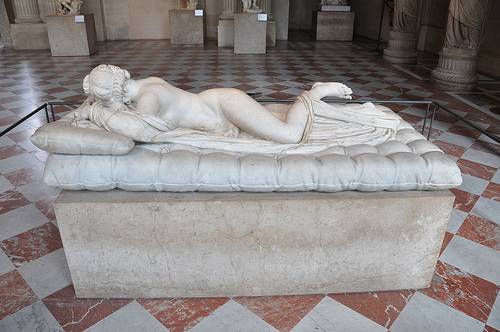Gender in the Contemporary Art World
After writing many times about traditional love in the contemporary art world, I thought, why not delve into its more devilish incarnations as well? Sex is a recurring subject in the art world. We’ll start with the rare hermaphrodite, someone who is both male and female. Incompatible with the traditional biological gender binary, this is of course fodder for great art. The first representation of a hermaphrodite the marble Borghese statue, which is found at the Louvre.
In the art world, there is are two types of hermaphroditism: the physical, as shown above, and the psychological. Pierre Molinier, a French artist born in 1900, could be described as mental hermaphrodite. His paintings are extremely delicate but also sensual and erotic, pushing the limit to pornography. There is also Andre Breton, father of Surrealism, who often referred to “convulsive beauty”, a peculiar and bothering beauty but impossible to detach his eyes from. Molinier was never really interested in Surrealism, as the group lost interest for his works when they became more popular. Rather, his research went much further in the esoteric and gender confusion. He has often represented himself as a shaman who managed a circle of young followers that have to be androgynous and beardless. His photomontages are disturbing. Especially those which represent him as a shaman, half male, half female.
Many artists were inspired by Molinier, including Robert Mappelthorpe, an American artist born in 1946. Photos made by Mappelthorpe are known for being shocking and subversive, depicting youths, flowers (orchids and lilies most often) and portraits in black and white. He received his first Polaroid in 1970. At this time he took his first portraits (friends, artists and socialites like Andy Warhol, Debby Harry, Richard Gere, Peter Gabriel, Grace Jones and Patti Smith) and self-portraits. A self-portrait he did in 1973 evokes Molinier, but it is more explicit and more sadomasochistic. Mappelthorpe also liked to dress himself up as a woman. For those unfamiliar with his work, it would be impossible to guess if the subject is a woman or a man.
Claude Cahun was a French photograph whose the real name was Lucy Schwob, born in 1894. She was well-known for her personal and political work. Her family was wealthy but she was lonely, sad and persecuted by children when she was young. She fell in love with her step-sister Suzanne Malherbe. Her first texts were published at the Mercure de France under the nom de plume «Claude», a unisex name chosen to confuse everybody. She was extremely interested in the question of gender and represented herself as a man most of the time. Cahun was the last name of her grandmother. She was looking for herself through her intimate, profound and autobiographical works.
Another artist who worked on gender issues but in a different way, without getting in the scene but instead watching, was American photographer Nan Goldin, born in 1953. She started working in the streets of New York, following the gay and transsexual communities. She wanted to make a documentary on the new wave, punk and underground art scenes. Her pictures are exhibited in the style of a diary. Sometimes they are organized like a short movie, sometimes they show the subjects in their own home in very intimate situations. Her photographs have often been the subject of sharp critics and judged too provocative, putting the viewer in the uncomfortable position of voyeur.
Gender issues have always been an interesting topic for artists. They question gender issues through their work and put the viewer in a very particular position to make him react.















